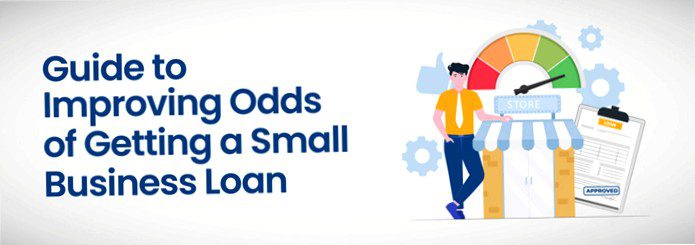Guide to Improving Odds of Getting a Small Business Loan

Running a small business can be challenging considering the financial requirements that follow to sustain or expand the business. In such times, small business loans can prove to be quite fruitful for your business. Some various financial institutions and banks provide you with MSME loans although, due to the competition, it might be taxing to get approval from the lender. Fortunately, by strengthening your loan application, it is possible to improve the odds of getting small business loans from your credits.
So, let us learn about how to apply loan for small business loans and other tips and tricks that might help!
A Robust Business Plan
Before you set out to apply for a small business loan, you should have a proper business plan explaining your ideas and goals. This will help you gain a better understanding of the amount of financing required to develop your small business keeping your long and short term goals in mind. You can also go into greater detail about where and how you intend to use the creditor’s funds. When you describe your project in detail, your lenders are more likely to perceive it as honest and reliable. A well-thought-out business plan that addresses financial projections and correct market analysis will have a better chance of being approved for small business loans.
A Strong Credit Score
One of the important factors taken into consideration by lenders and other financial institutions is your credit score. It is the basis on which the lender can assess the ability to repay the loan. The credit history can be summarised by a ‘CIBIL’ or ‘credit score,’ which is assigned to each individual who has a credit card. A CIBIL or a credit score is a 3 digit number, ranging from 300 to 900 reflecting a summary of the users’ credit history. A higher credit score implies that a borrower is at a low risk and more likely to make payments on time. You can find a credit score from agencies like CRISIL or ICRA. Many lenders respect a good credit score as it indicates that a person has been consistent in all their loan repayments, in a timely fashion. There are numerous ways to increase your credit score. Ideally, start by paying off all outstanding invoices and expenses as soon as possible. Then, maintain a credit usage ratio of roughly 25% at all times. If necessary, open additional credit accounts to manage non-business debt in a separate account. This should improve your credit score as well as the chances of procuring a small business loan.
Ensuring Good Cash Flow
Your cash flow is one of the key indicators that lenders use to analyses your organization’s financial health. They understand that potential borrowers with positive cash flow are more likely to make future payments on time. The cash flow numbers highlight the liquidity status of your business. For the lender to consider your MSME loan application, your liquidity position must show stability. It is important to understand your liquidity position before reaching out to the lender. By eliminating unnecessary business expenses that affect your cash flow directly and practicing better cash flow management, you can improve your liquidity status. With better cash flow, it becomes more likely for the lender to fund your small business.
Prepare Documentation
Many lenders will ask for additional documentation to back up your application. This could be financial statements from the last three years, business certificates, or proof of ownership for collateral. Depending on the kind of financial organisation you are seeking assistance from, the requirement of the documents may vary. Banks usually require extensive paperwork to aid your application whereas, at NBFCs the process might be simpler. Before you submit your application, contact your lender to find out what documentation they require. This will prevent any surprises during the procedure, as well as delays. Keep your GST, income tax, credit-related, and registration paperwork to prepare for an SME company loan application. If your company’s legal documents include any gaps, fill them out before applying for an SME term loan. Getting a head start will minimize the headaches and ensure everything progresses smoothly.
Loan Repayment Strategy
It is best to be transparent with your loan creditor about your intentions and plan to repay your loan. This helps in building trust and confidence. Online EMI calculators can help you create a repayment plan. It is important to consider the worst-case situation and build enough safeguards to repay your business loans. Communicating your strategy along with a backup plan indicates to your lender that you are diligent with your finances and prepared for all possible outcomes.
Take Financial Advice
If you are unsure how to develop a loan plan or have questions about other areas of borrowing, get professional guidance. It could be from any source you trust or even those provided by the institutions. Understanding what is best for your business and acting on it is the right step to take. Therefore, having knowledgeable people review it so that any gaps or weaknesses can be fixed in advance proves to the creditor that you have evaluated the environment surrounding your business very well.
Procuring a small business loan might seem like an intimidating process but it is nothing to worry about. These tricks might not seem out of the ordinary but play a key role in improving the odds of getting a small business loan. With a little more diligence, timely repayments, planning, and simplified management it becomes much easier to get an MSME loan. Various NBFCs provide quick and hassle-free business loans. These loans are collateral-free and require less paperwork and suit all your business needs.